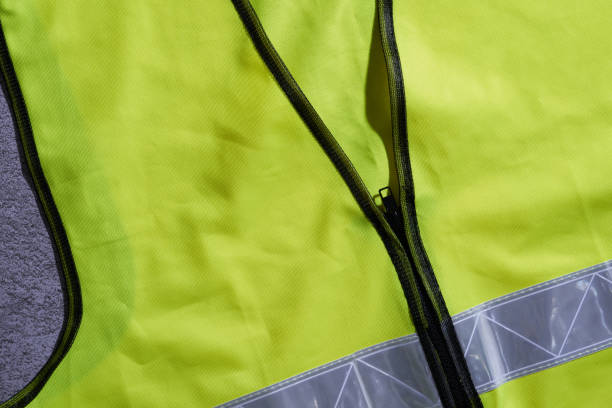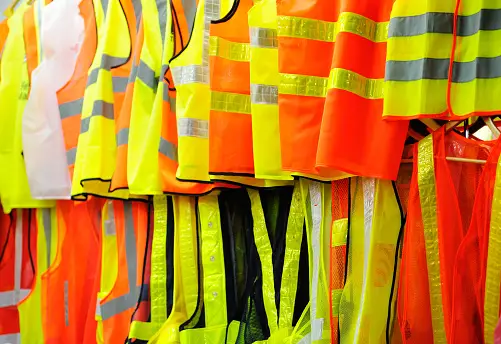Ever wondered how your reflective jacket is made? You’re about to find out! We’ll pull back the curtain on the process, showing you the innovation and high visibility technology that goes into each piece.
We’re diving into the world of high-visibility gear, exploring how safety meets style. You’ll discover what makes these jackets so effective and why they’re a must-have for your wardrobe.
Ready to illuminate your understanding? Let’s shine a light on the mystery of reflective jackets.
What Are High Visibility Jackets?
High visibility jackets, often termed ‘hi-vis’, aren’t your typical outerwear. They’re specifically designed with reflective materials and bright colors, like neon yellow or orange, to ensure you’re easily noticeable in low-light conditions or amidst a busy background.
Whether you’re exploring their use in fashion, the ANSI safety standards they meet, or the different types such as hi-vis coats, understanding how these jackets work can truly help you stand out.
Reflective Jackets In Fashion
Surprisingly, you’re seeing reflective jackets everywhere in fashion these days. These garments, once exclusive to workers in high-risk environments, have been innovatively reimagined into unisex fashion staples. The process of creating these jackets is meticulous, requiring precision and technical prowess.
The reflective element is achieved by embedding tiny glass beads or prismatic elements into the garment’s fabric. These materials reflect light back to its source, creating a noticeable glow. The color of the jacket doesn’t affect the reflective quality, so you can choose a hue that suits your style.
Reflective jackets are the embodiment of fashion meeting functionality. As the world becomes more safety-conscious, you’re not just making a fashion statement with these garments; you’re also protecting yourself.
Hi-Vis Safety Jackets (ANSI)
You’re now delving into the realm of Hi-Vis Safety Jackets (ANSI), a crucial gear for ensuring safety in high-risk environments.
As an enthusiast for cutting-edge solutions, it’s essential to comprehend the technicalities behind these safety jackets. Hi-Vis Safety Jackets are meticulously designed for high visibility. Their reflective materials bounce back light, ensuring the wearer is seen in low-light conditions.
These jackets are crafted following the ANSI/ISEA 107 standards, which dictate the minimum area of high visibility materials and the performance of reflective components.
In a world that’s rapidly embracing automation and AI, safety high visibility gear is evolving too. Innovations are underway to incorporate smart technologies into these jackets, aiming for a future where safety isn’t just visible, but also interactive.
Hi-Vis Coats
In your exploration of hi-vis gear, you’ve probably encountered a variety of hi-vis coats, but it’s the science behind them that’s truly fascinating. These high visibility jackets are engineered using advanced technology to ensure visibility and safety. Using retroreflective materials, hi-vis coats bounce light back towards its source, making you highly visible even in low-light conditions.
High visibility reflective vests, another essential safety gear, incorporate micro-prismatic technology. Tiny prisms on the vest’s surface refract light, enhancing the garment’s visibility.
Viz jackets, on the other hand, employ fluorescent fabrics that absorb UV light and re-emit it, creating a glowing effect in daylight.
These innovative approaches to safety gear design are a testament to the impressive advancements in high visibility technology.
What Is Reflective Material?
You’ll often find reflective material on safety clothing because it effectively bounces light back to its source, making it highly visible in low-light conditions. This technology is what makes your high visibility jacket or safety vest stand out in the dark. It’s not just about wearing a bright color, but having a material that reflects light back, creating a glow that’s hard to miss.
The reflective material is embedded in the fabric of visibility jackets, typically in the form of small glass beads or microprisms. These components are designed to refract light, a process that effectively redirects it back towards the original light source. This is the crux of what makes hi vis jackets so effective and crucial for safety in low light environments.
How To Create a Reflective Jacket
First, you start with the raw materials, predominantly polyester or cotton, which are woven into the fabric that forms the basis of your jacket.
Next, you apply a layer of reflective material, typically made of tiny glass beads or microprisms, which catch and bounce back light, making the jacket highly visible in low-light conditions.
From Raw Materials To Your Jacket

Creating a reflective jacket starts with sourcing the right raw materials, primarily polyester fabric and tiny glass beads for reflectivity. You’ll need to coat the fabric with the beads, ensuring they’re embedded securely to provide the desired reflective quality.
Once the fabric is prepared, it’s cut and sewn into the jacket design, resulting in a garment that’s both stylish and safety-conscious.
What Materials Are Reflective?
There are several materials you can use that are reflective, such as glass beads, microprismatic sheeting, and aluminum.
For your high visibility coat, opt for polyester, not cotton. It provides UV protection, longevity, and maintains the reflective quality.
Microprismatic sheeting, embedded in the fabric, enhances the reflectivity, making you more visible in low light.
The Creation of Reflective Materials
You’re delving into the fascinating process of how reflective materials are made for use in items like safety jackets. These reflective elements, crucial to high visibility vests and clothing, are created using tiny glass beads or microprisms.
The beads are coated in a reflective layer and then embedded into the fabric of the visibility jackets. This process ensures that light hitting the hi vis material is reflected back, making the wearer noticeable even in low-light conditions.
Moreover, these safety jackets undergo strict testing for durability and reflectivity. Tests include exposure to extreme weather conditions, washing cycles, and abrasion resistance.
The result? A jacket that not only enhances your visibility but also withstands the rigors of your environment. This is innovation at its finest, keeping you safe while pushing boundaries.
Hi Vis Reflective Jacket Assembly
In assembling a hi vis reflective jacket, you’re not just piecing together fabric, but integrating essential safety features. Each component enhances visibility while ensuring durability.
The hi vis jacket assembly process starts with selecting high-visibility fabrics, often in neon shades. Next, you’ll affix the reflective tapes. These are strategically placed to catch light from all angles, ensuring the wearer’s safety.
The safety jacket is then sewn together, paying careful attention to seams for water resistance and durability.
The final product, a hi vis reflective jacket, isn’t just a garment, but also safetywear. This innovative process represents an intersection of fashion and functionality, offering protection for those who work in low-light conditions.
The Features of Premium Reflective Jackets
You’ll notice that premium reflective jackets are constructed from high-grade fabrics and materials, ensuring durability and long-lasting performance.
They come in a variety of colors, each designed to provide maximum visibility, especially in low-light conditions.
Not to mention, they’re water-resistant, offering an additional layer of protection against harsh weather conditions.
Fabrics & Materials
With a focus on fabrics and materials, let’s delve into the features that make a reflective jacket premium quality.
Knowledge of the right fabric is key to creating high vis jackets that truly stand out. You’ll find that the most effective hi visibility jackets utilize micro-prismatic technology, which increases reflectivity. This feature is woven into the fabric itself, ensuring that the vis jacket maintains its high visibility even after numerous washes.
The material of the jacket also needs to be durable and weather-resistant to protect you in harsh conditions. High visibility clothing often incorporates polyester, a fabric known for its strength and resilience. It’s also lightweight, enabling you to move freely.
Hence, when it comes to fabrics & materials, it’s crucial to prioritize reflectivity, durability, and comfort.
Colors

You’re going to love the wide range of vibrant colors that these premium reflective jackets come in. From bold hues to subtle tones, every color is meticulously chosen to enhance visibility and style.
The fiery reds, cool blues, and even a punchy lime are all available for your selection. These jackets’ colors aren’t just for aesthetics; they play a crucial role in safety too. The luminous colors increase your visibility, especially in low light conditions.
The vis jackets, in particular, are known for their high-visibility colors and light-reflecting properties. You’re not just wearing a jacket; you’re wearing innovation. It’s a blend of safety, style, and technology.
Water Resistance
Despite the vibrant colors, it’s the water resistance feature in these jackets that’ll truly impress you, providing protection against rain and snow. Your coat is designed using an innovative, high vis safety technology. This feature increases the visibility in various weather conditions — an essential for your safety.
The water resistance is achieved through a technical process. Manufacturers apply a durable water repellent (DWR) finish, allowing the fabric to resist water while remaining breathable. This protective layer prevents rain from saturating your coat’s outer fabric, causing it to ‘bead up’ and roll off.
In essence, this water resistance feature doesn’t just add to the longevity of your coat but also ensures your comfort and protection. So, you’re not just wearing a jacket, you’re wearing a shield against nature’s elements.
High Visibility Features
Not only do you stand out in the crowd, but you also light up in low-light conditions, thanks to the jacket’s high visibility features that bounce back light.
This hi vis visibility safety function is achieved through innovative fabric technology. Manufacturers embed thousands of tiny glass beads in the fabric, which reflect light back to its source, making you visible even from a distance.
This high vis technology, often found in safety vests, is also applied to reflective jackets. These high visibility features aren’t just for show; they’re lifesavers, especially in hazardous work environments or during nighttime activities.
Embrace this ingenious blend of fashion and technology that not only ensures your safety but also places you at the forefront of innovative wearable technology.
Should You Buy A Hi-Vis Jacket?
Considering a hi-vis jacket?
You’ll need to weigh the cost, evaluate how it aligns with your personal style, and determine if it suits your preferences.
It’s important to remember that these jackets aren’t just about standing out – they’re about safety, functionality, and often, compliance with certain work regulations.
High Visibility Jacket Pricing
You’ll find that high visibility jacket pricing varies greatly depending on the brand and quality of materials used. High-end brands invest in superior materials and innovative design, resulting in hi vis coats that offer unparalleled safety and durability. These safety coats often come with a premium price tag due to the enhanced features they offer such as reinforced stitching, advanced reflective materials, and optimal fit for maximum comfort.
On the other hand, you’ll find viz coats from lesser-known brands at lower price points, but they may not offer the same level of protection or durability.
Always remember, when it comes to high visibility jacket pricing, it’s not just about cost, but also about the quality and safety features that can keep you secure in hazardous conditions.
Your Style
In deciding whether to buy a hi-vis jacket, it’s important to consider your personal style as well as the three key factors: safety, durability, and cost.
Your style can be personalized with a variety of brands, each offering unique features. Reflective jackets aren’t just about safety anymore; they’re about making a statement. You can choose from jackets with a black bottom to hide dirt or ones featuring a bold logo for a striking look.
It’s key to remember, however, that your style should never compromise safety. A jacket’s reflectivity must meet specific standards to ensure maximum visibility. So, while investing in a hi-vis jacket, prioritize function but don’t dismiss fashion. After all, innovative designs make it possible to blend both seamlessly.
Your Preference

When it comes to hi-vis jackets, what’s your preference based on the factors of style, safety, durability, and cost?
Reflective jackets, made with precision and a keen eye for detail, offer an inside look into the intricate process of their production. You’d be amazed at how each layer, each stitch, each reflective strip is contextually relevant to the overall functionality and design of the jacket.
Your preference might lean towards a jacket with an innovative design, but never underestimate the importance of safety features. The reflective strips, for instance, aren’t just stylish add-ons. They’re strategically placed to enhance visibility in low-light conditions. Similarly, the jacket’s material is carefully chosen to ensure durability without compromising on comfort.
Frequently Asked Questions
What Are the Safety Standards for Reflective Jackets?
You’re looking at standards like EN20471, which dictate high levels of reflectivity, visibility in low light, and color contrast. They’re critical to ensure you’re seen and safe in hazardous conditions.
How Long Does It Typically Take to Manufacture A Hi Vis Jacket?
You’re likely curious about production time. Typically, it takes about 2-3 hours to make one reflective jacket. This includes designing, cutting, sewing, and adding reflective elements. It’s a precise, meticulous process.
What Is the Average Lifespan of a Reflective Jacket?
You’d typically get five years out of a reflective jacket. However, its lifespan could decrease with frequent use and exposure to harsh weather conditions. Proper care and maintenance can extend its reflective properties.
How Do I Properly Clean and Maintain a Reflective Jacket?
To properly clean and maintain your reflective clothing, you’ll want to hand wash it in cold water with a mild detergent. Avoid bleach and fabric softeners. Air dry it to preserve its reflective properties.
Are There Different Levels of Reflectivity in These Jackets?
Yes, there are varying levels of reflectivity in these jackets. It’s all about the amount and type of reflective material used. More high-quality material means higher reflectivity, ensuring you’re seen in low light conditions.
Conclusion
So, now you’ve got the scoop on how reflective jackets are made. From the high-visibility material to the intricate process of design, it’s clear these jackets are more than just a safety accessory.
They’re expertly crafted pieces that can save lives. With all the benefits they offer, there’s no reason not to invest in a hi-vis jacket.
Stay safe, stand out, and let your jacket do the talking.
Published by HOLR Magazine.



